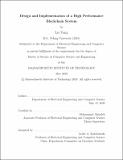| dc.contributor.advisor | Mohammad Alizadeh. | en_US |
| dc.contributor.author | Yang, Lei,S.M.Massachusetts Institute of Technology. | en_US |
| dc.contributor.other | Massachusetts Institute of Technology. Department of Electrical Engineering and Computer Science. | en_US |
| dc.date.accessioned | 2020-09-15T21:51:53Z | |
| dc.date.available | 2020-09-15T21:51:53Z | |
| dc.date.copyright | 2020 | en_US |
| dc.date.issued | 2020 | en_US |
| dc.identifier.uri | https://hdl.handle.net/1721.1/127317 | |
| dc.description | Thesis: S.M., Massachusetts Institute of Technology, Department of Electrical Engineering and Computer Science, May, 2020 | en_US |
| dc.description | Cataloged from the official PDF of thesis. | en_US |
| dc.description | Includes bibliographical references (pages 61-64). | en_US |
| dc.description.abstract | Bitcoin is the first fully-decentralized permissionless blockchain protocol to achieve a high level of security: the ledger it maintains has guaranteed liveness and consistency properties as long as the adversary has less compute power than the honest nodes. However, its throughput is only 7 transactions per second and the confirmation latency can be up to hours. Prism is a new blockchain protocol that is designed to achieve a natural scaling of Bitcoin's performance while maintaining its full security guarantees. In prior work, Prism's security and performance properties have been analyzed theoretically, but the analysis relies on a simple network model and specifies performance bounds up to large constants. Hence, the results cannot predict the protocol's real-world performance. In this thesis, we present a Bitcoin-like payment system based on the Prism protocol and evaluate it on a network of up to 1000 EC2 virtual machines. Our system achieves a throughput of over 70,000 transactions per second and a confirmation latency of tens of seconds, validating the prior theoretical results. We introduce several optimizations that allow the system to scale linearly up to 8 CPU cores, and a new algorithm to confirm transactions that is faster and more practical than the original protocol. We also evaluate practical security concerns like the censorship attack, the balancing attack, and spamming, and propose a simple solution that reduces spam traffic by 80% while only adding 5 seconds to the confirmation latency. | en_US |
| dc.description.statementofresponsibility | by Lei Yang. | en_US |
| dc.format.extent | 80 pages | en_US |
| dc.language.iso | eng | en_US |
| dc.publisher | Massachusetts Institute of Technology | en_US |
| dc.rights | MIT theses may be protected by copyright. Please reuse MIT thesis content according to the MIT Libraries Permissions Policy, which is available through the URL provided. | en_US |
| dc.rights.uri | http://dspace.mit.edu/handle/1721.1/7582 | en_US |
| dc.subject | Electrical Engineering and Computer Science. | en_US |
| dc.title | Design and implementation of a high performance blockchain system | en_US |
| dc.type | Thesis | en_US |
| dc.description.degree | S.M. | en_US |
| dc.contributor.department | Massachusetts Institute of Technology. Department of Electrical Engineering and Computer Science | en_US |
| dc.identifier.oclc | 1191905988 | en_US |
| dc.description.collection | S.M. Massachusetts Institute of Technology, Department of Electrical Engineering and Computer Science | en_US |
| dspace.imported | 2020-09-15T21:51:52Z | en_US |
| mit.thesis.degree | Master | en_US |
| mit.thesis.department | EECS | en_US |
